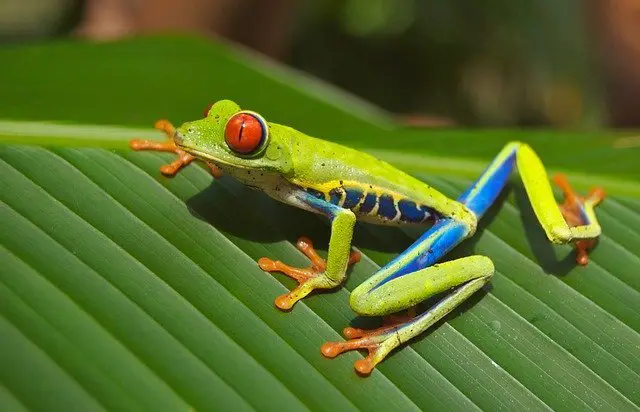Young red-eyed tree frogs, like most frogs, grow up without much care from their parents. After a male and female red-eyed frog breed, they usually move on and leave their offspring to fend for themselves. However, during the reproduction process, red-eyed frogs usually choose a safe leaf above water and may fold the leaf to keep the eggs out of any predator’s sight.
Are the parents good?
How devoted and caring are the mothers and fathers of the amphibian world? Do the conspicuously red-eyed tree frogs care for their young or leave them to fend for themselves?
Parental behaviors in toads and frogs vary a bit depending on multiple factors such as the species and the habitat. Today we will specifically talk about red-eyed tree frogs.
Adult red-eyed tree frogs have excellent camouflaging abilities and they are great jumpers as they spend most of their life in trees. During the day, they remain completely still, fold their blue sides and bright red feet underneath their body and close their distinctive red eyes, making their green upper bodies almost invisible to predators, camouflaged against the green leaves.
But what about their offspring? How do red-eyed frogs take care of their young? Do most of the eggs survive or are they captured by predators before they reach maturity?
We will answer all these questions and more in this article.
The life of a young frog
Let’s start right from the mating process and see how adult red-eyed tree frogs lay eggs and care for them.
Choosing a leaf to lay eggs
When an adult male and female frog mate, the female chooses a leaf above water. This could be a pond or even a puddle. This is so that the offspring can fall right into water when they hatch. The female lays the batch of eggs on the leaf and sometimes folds the leaf in such a way that the eggs are hidden from predators.
Moreover, the eggs are glued together with a sticky substance that the frogs produce to prevent the eggs from falling, to keep them together, and to let them stay hydrated so they do not prematurely split.
The eggs develop into tadpoles. Meanwhile, the parent frogs usually part ways with their offspring and get on with what’s left of their life on the trees around the pond. Sometimes, the frogs might occasionally come to watch their eggs. But, for the most part, the eggs are left to fend for themselves.
Since red-eyed tree frogs lay eggs on both sides of the leaf, the eggs have to protect themselves from all sides- from predators on the trees (snakes, monkeys), fish in water, and even aerial predators.
But even without their parents, the eggs have a self-regulated mechanism for protection. Whenever they detect vibration from a predator very close by or face any harsh storm-like weather, they feel threatened. As a response, the tadpoles get excited and hatch early, then spread out to escape.
Tadpoles need water to survive though, and cannot live for more than a day on land. This is why tree frogs lay their eggs on a leaf above water so that as soon as they split, the tadpoles fall into the water, where they have a better chance of growing and surviving.
Hatching and life in the water until metamorphosis
On the sixth or seventh day, when the tadpoles are ready to hatch, they start moving around vigorously inside the egg. This causes the eggs to crack open, releasing the tadpoles and a little water which helps the tadpoles slide down and fall straight into the water with a plop.
Even now the tadpoles are on their own, struggling to stay alive. It can take them around a month to several months to metamorphose and develop into froglets. This duration depends on their environment and their larval stage.
The tadpoles live in the water, feeding on tiny insects, and protecting themselves against aquatic predators. Many of the tadpoles do not make it to their final developmental stage and are eaten by predators in the water. The hatchlings must detect approaching predators (fish and shrimps etc.) and flee.
The young ones that survive their first few weeks become more agile, and then move into undergrowth and hollows of plants near the pool to protect themselves. Within a few months, when the tadpoles have transformed into frogs, their brains and limbs much more developed now, they are more agile and can leave the pond to live their lives on the trees nearby, like tree frogs.
Do some frog species care more for their offspring?
Yes! The amount of care is also said to depend on the size of the water body. Frogs living around larger bodies often careless.
Although red-eyed tree frogs, like most frog species, are not known to help their young, some rare species do have ways like carrying their offspring around in a pouch on their bodies, making protective nests out of foam, sitting on their eggs like birds, and sticking around the nesting area to ward off predators!
[su_box title=”Our Tree Frog Guide “]We hope you have enjoyed this article and we have answered your question. Are you considering keeping the red-eyed tree frogs? Then if you are you have to take a look at our guide to keeping these wonderful creatures. It contains everything you will ever need to know. Just click here to have a look.[/su_box]




